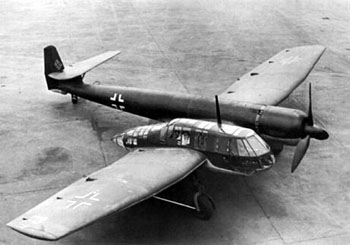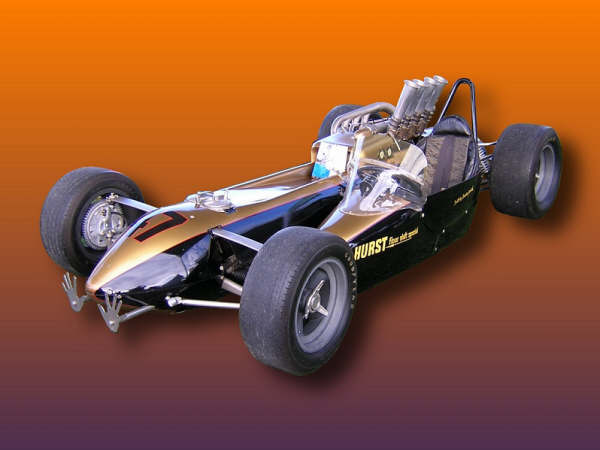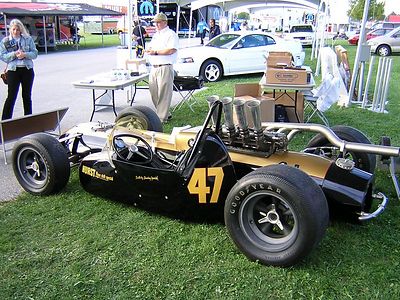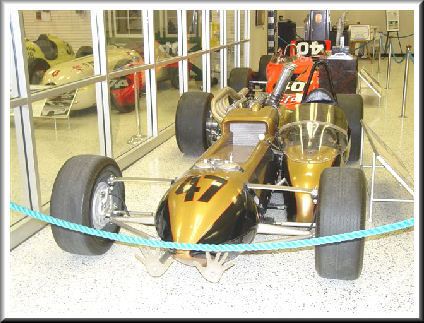It was only matter of time before one of Smokey Yunick’s creations found its way to this section of our blog. It wasn’t any easy choice on which way to go for the first one, either. An argument could be made for any number of his cars starting back in the day of his work with Hudson Hornets, through his wild Trans-Am Camaro, and into his Indy efforts. Then there’s the mythical 7/8th Chevelle. Yunick denied that car existed right up until his death.
But here’s the Pod car, or as it was known on the track, the Hurst Floor Shifter Special. It was one of the most wild creations to ever race its way around the Indianapolis Motor Speedway. It was born from the mind of a mechanical genius and came to represent everything great about the wide open creative nature of the Indy 500. It wasn’t a race winner as you’ll see, but it stood the racing world on its ear.
To start with, if you can believe it, the car was going to be far more wild than it actually turned out. Yunick was planning on this car being turbine powered, but the expense of the turbine was too much for him to bear so he settled for an Offy. The driver was going to control the throttle and brake with one dual-action pedal and the clutch was going to be actuated by the gearshift lever, which would also work changing gears. Like we said, as crazy as this car turned out, it was planned to be otherworldly. Another thing to note is that there were less than four months until testing began and this car existed in Smokey’s head only, not one bolt had been turned, one part milled, or one piece bought. The one thing he did have was $40,000 of George Hurst’s money.
So, you’re asking, where the idea for this freak of a car come from? During WWII, Smokey was a pilot, flying B-17s. On one flight over Germany he saw a weird looking plane that had the motor mounted in the center and the pilot was located off to the side in a small pod. This plane was the German built Blohm and Voss 141 (see the photo). The logic behind the design of the plane was that two small shapes that present the same frontal area as one big one create less resistance while moving through the air.

Adding the Offy motor was not a big physical challenge, but it did present a mental challenge on how to get the air through a radiator to keep the motor cool. It took some thought before Smokey settled on a (trick for the time) aluminum crossflow radiator.
Quoting Yunick from his book, Best Damn Garage in Town, he writes, “I give my first idea a try in my wind tunnel and first shot out of the barrel I got it. Man, simple and effective as well. Aluminum cross flow radiator. Only people that can make ‘em then was Harrison Radiator in Rochester, New York. A famous tech writer in a wheel chair wrote it would run hot, and in general wrote eight pages of negative stuff. Turned out he was as full of shit as a Christmas Turkey.”
Bobby Johns was selected as the driver. Yunick knew and liked Johns, but he was an untested commodity at Indy, or in any open-wheel car because he’d never driven one. Talk about a steep learning curve! Going from never even sitting in an open-wheeler to driving one of the most radical ones ever built for the time. Johns was a guy known for making the best out of second-class rides and also got the reputation for being easy on equipment or not being a “wall banger” as Yunick said.
With only days before testing was to begin, Yunick and friend Bradley Dennis found a fatal flaw with the rear suspension setup on the car. In a marathon session, Yunick cut the rear of the car off and converted it from a “four bar” (his words, but we suspect four-link) to a “two bar” setup.
The next hurdle, and it was admittedly a small one, was the new rule mandating that all cars in competition be equipped with a bumper. Yunick, always the provocateur, traced the hands of his son on a piece of steel and milled out two mitts, mounted them on steel bars and they passed tech with flying colors!
When the wrapper came of the car at Indy the reaction was as to be expected: total disbelief. Lots of people called him crazy and several more called Johns crazy for climbing into the car, but there was one guy who was fixated on it.
Colin Chapman, the man behind Lotus and one of the great designers and thinkers of modern racing, became obsessed with the car. On Chapman, Yunick said, “We had garages pretty close together. I knew him for several years but he ignored me like a commoner. I respected and admired his talent but not quite his game of cutting ‘er close on ‘safe.’ I got to know him quite well over the next three weeks. He was probably one of the five best in the world but he had an ego the size of an elephant.”
While Smokey had an easy shot through tech with his “handy” bumpers, the rest of the car was gone over closer than probably any other in race history. It took four days for the inspectors to even allow the car an attempt at the track. The two problems that held the car up were not what you’d expect, but Smokey’s solution to prove his point was everything you’d expect from him.
Problem one was the removable steering wheel. This was the first car to ever have a removable steering wheel. Yunick invented it. The type of wheel found in every Stock Car, most dragsters, and tens of thousands of racers around the country first saw the light of day in this car and the tech guys hated it. They were convinced it was going to come off in John’s hands and results in his death. The paradox was that because of the size of the capsule, the only way in and out was to take the wheel off. The tech guys wanted it to be safety-wired on, but then the driver would be trapped in the car. Yunick took the whole unit off, handed it to the tech department and told them to do their worst to get the wheel off.
They couldn’t and he won.
The second issue was that the inspectors did not like the fact that the capsule was attached with only five bolts to the rest of the car. Yunick pulled the bolts out, handed them to the tech inspectors and told them to do their worst to bend, break, or compromise them.
They couldn’t and he won.
The car passing tech, the last hurdle was the rookie driver in the seat of a weirdo car he had absolutely no experience in. His inexperience was preyed on by other drivers according to Yunick who were actively trying to convince Johns that the car was a death trap. Yunick always had a sense of pride in having his cars meet or exceed safety standards of their day and this one was no exception.
Unfortunately, it seems that the brainwashing was effective as Johns was slow on the track during the first weekend of qualifying. Yunick laid down the law with Johns and told him that is he were not comfortable or able to drive any faster, he’d be pulled from the seat. The speeds increased, and although inconsistent, were going to be good enough to make the field.
“Bobby (Johns) can’t tell me what the car is doing, ‘cept it feels ‘spooky’. What does ‘spooky’ mean? I never studied Halloween or ghosts so spooky to me is like a 24 letter word. I didn’t know what it meant. I finally figured out the car needs rear sway bar. I had one but never tried it. He’s plenty fast but inconsistent. I’m sure the car is twitchy,” Yunick remembered.
On the last day of qualifying, Johns took the car out and the first lap he laid down was good enough to make the field. The second lap resulted in him backing the car into the wall, and being a rear-engine car, it was basically lights out. Johns walked away from the wreck, proving the point that the car was not unsafe.
Yunick says in his book, “That backed ‘er into the wall. The damage was not too bad, but the ass end of the car was the oil tank and oil cooler, all custom made crap. Bobby’s not hurt but Indy 1964 just went to shitsville. That deal is an example of how fast life can change. And you know nothing really terrible happened. No red stuff spilled. It was just a twenty ‘G’ mental crash.”
The car was repaired and was going to make another run at Indy for the next season when it was outlawed by a rule change designed to shut out the turbine-powered cars. The rule changed the area where the body could and couldn’t be and the location of the capsule was smack dab in the effected zone and was not able to be altered. It was over for the car.
It now sits in the basement of the museum of the Indianapolis Motor Speedway as a testament of a brilliant mechanical mind who was unafraid to try anything. Sure it wasn’t a race winner, but it certainly opened the eyes of a lot of people to how free thinking Yunick was. He’s a lot more than small-block Chevy motors.
As an aside, the weekend that the car was wrecked was also the weekend that Smokey’s dear friend Glenn “Fireball” Roberts was mortally wounded in a Stock Car wreck that left most of his body very badly burned. Smoke rushed from Indy to Charlotte in order to see his friend. Roberts died a month later from the burns.
This probably won’t be the last Yunick car that hits this section of the site, but it will certainly be the wildest. Others used lots of tricks and clever thinking, but this one was a clean-sheet design that cemented Yunick as a force to be reckoned with on the biggest stages in the world. We wish both he and Chapman were still around to yak about it.
























